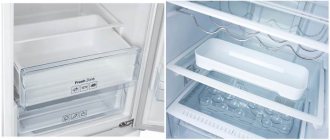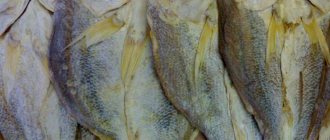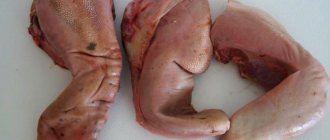Posting in the group: Useful tips
There are several options for defrosting fish: steamed, in water, in the refrigerator compartment and in the microwave. The main thing is that the product thaws slowly. This is due to the fact that it has a very delicate fiber structure, which, if handled incorrectly, will become dry, hard and lose many useful components. To eliminate this situation, it is necessary to defrost the fish in advance. However, there are several ways to quickly remove ice crust from the surface of a product.
In water
The optimal method for defrosting fish is to place it in a container with cold water. Take a couple of plastic bags, place a frozen carcass in them, and tie the bags to prevent moisture from entering. After this, the bag with the fish is placed in a spacious container - a saucepan or basin; a bath is also suitable. Then pour cold water. In a couple of hours the fish will be ready for cooking.
Do not use warm water, as this will damage the meat fibers. For more intensive defrosting, it is advisable to periodically change the water to colder water.
This method of describing how to defrost fish is the most gentle and yet a slight loss of moisture cannot be avoided.
If you need to defrost the fish even faster, you should sprinkle it with salt. How much to take, each housewife decides independently. It is allowed to pack fish in plastic bags. Salt helps the ice crust melt quickly.
The above method of defrosting in salted water can be called the best for standard and small-sized fish. It is not recommended to defrost large carcasses in water. This leads to a decrease in the quality of the product - the meat begins to swell and its structure deteriorates significantly. You need to know what kind of fish is defrosted in water. These include freshwater and marine life.
Yandex pictures
How not to defrost
The process of defrosting fish must proceed correctly. The preservation of the properties and taste of the product depends on this. Therefore, you need to try to avoid various process errors.
When carcasses are thawed, a change occurs in the colloidal structures of their muscles. This leads to loss of juice. And the more it goes away, the more the taste will change after cooking.
Note: It is not recommended to defrost fillets in salted water. This may reduce the nutritional value of the product and change its color. You should resort to this type of defrosting only in extreme cases.
Yandex image
It is recommended to adhere to the following tips:
- Do not use hot water so that frozen fish becomes simply raw. At temperatures above 35 degrees, fish protein begins to lose its properties. To replace the lost juice, the carcass absorbs hot liquid. As a result, the product becomes loose. This option is allowed only in extreme cases;
- It is not necessary to defrost the product completely until it is soft. The fish should remain elastic, dense, and chilled. Then it will be easier to prepare;
- As soon as the defrosting process is completed, they immediately begin preparing the chilled product. Otherwise, the fish product will lose its properties and vitamins.
Microwave
It is also possible to defrost fish using a home microwave. You will need a microwave-safe, heat-resistant bowl. The carcass is placed in it and the appropriate operating mode is set. To ensure that the frozen product thaws evenly, it is advisable to turn the fish carcass or fillet over once, turning off the household appliance. This method is best for whole carcasses, small fish, as well as semi-finished products - minced meat, fillet, etc. The disadvantage of this method is that it is impossible to microwave large fish. Before the procedure, you will have to cut a large fish into portions.
Many people note that after defrosting in the oven, the taste of the fish becomes specific.
How long does defrosted fish last in the refrigerator?
Experts insist that after defrosting, you should immediately begin heat treatment of the fish. In extreme cases, storage in the refrigerator for no more than two hours is allowed. To do this, the fish must be wrapped in a damp cloth or placed in a container with a lid. However, fillets cannot be stored even in this form. And you should not re-freeze the product, as another defrosting cycle will make it harmful to health.
Before defrosting the product, choose the appropriate method, taking into account the size and type of fish, freezing conditions, and cutting method. It is better to give preference to the universal and correct method - thawing in the refrigerator. If time is limited, defrost the product using a microwave, double boiler, or oven. Or use simple methods that do not require electrical appliances. Follow the recommendations for defrosting, then the result will please you with a juicy fish dish.
Thawing
This method involves natural defrosting at room temperature. It is advisable to cover the fish with film so that less moisture evaporates from it and during cooking it is not hard and dry. You should not cover the fish with film during the hot season, otherwise the product may quickly deteriorate.
Following the correct technology ensures that the fish carcass defrosts slowly and retains all the properties of chilled fish.
The correct method is natural thawing on the bottom shelf of the refrigerator. Thanks to the slow process, the quality of the product does not suffer. This is the essence of the question of what fish thawing is.
The only disadvantage of natural defrosting is the long period of time, at least 6-8 hours.
The package containing the purchased fish must be pierced in three to five places. It would be enough.
The unpackaged carcass should be wrapped in cling film, placed in a pan with thin walls and placed on the bottom shelf of the refrigerator for 8-10 hours. After the fish has thawed, it is freed from the cling film, the released liquid is removed and blotted with paper towels.
The natural method of thawing, ranging from 7 to 11 hours, is most suitable for sturgeon, beluga, and hake.
Yandex pictures
Simple instructions for defrosting fish
If you want excellent fish after defrosting, follow the step-by-step instructions:
- Remove the fish from the freezer, do not remove it from the vacuum packaging.
- Take a plate and put the product on it.
- Place the fish on the bottom shelf of the refrigerator (temperature 0 to 5°C) and leave overnight.
- If the temperature in the refrigerator is above 5°C, 6 hours will be enough.
The chef recommends starting cooking when the fish is still cold. Room temperature may cause pathogenic bacteria to form on the product. Such fish runs the risk of being spoiled. So if you take longer to defrost fish, continue to keep it in the refrigerator.
In the oven
The non-standard method of quickly defrosting fish is distinguished by the fact that it does not reduce its taste. The frozen carcass should be placed on a fireproof baking sheet and placed in the oven on the lower rack. There are certain temperature restrictions. The heating temperature should not exceed 30 degrees. It is allowed to use convection mode for defrosting with the temperature set at 0 degrees.
Advice: to make uncut carcasses quicker and easier to clean, it is not recommended to thaw them until they become soft.
Re-freezing
It is not recommended to re-freeze a thawed product as it will lose its taste and structure. Fish must be frozen in order to protect it from the development of dangerous bacteria under the influence of low temperatures.
When a fish carcass begins to thaw, microorganisms appear on its surface and get there in various ways. Under their continued influence, it begins to deteriorate. In this regard, it is necessary to defrost such a volume of product that is necessary for preparing the delicacy.
For a couple
To avoid loss of nutrients and reduce the weight of the fish carcass, it is advisable to defrost it in a steam bath. A double boiler or multicooker, where the water does not come into contact with the carcass, is well suited for this procedure. The described method is especially effective on how to properly defrost fish if subsequent cooking will be carried out in a double boiler or slow cooker. The entire defrosting process takes 10-15 minutes.
The main disadvantage of thawing steamed fish is the loss of rich flavor.
The fish should be placed on the grill of the multicooker, selecting the minimum setting. From time to time the fish needs to be turned over. When it is freed from ice captivity, you can switch the kitchen appliance to frying mode or subject it to another type of culinary processing.
How to defrost fish correctly
Frozen product is not inferior to fresh in terms of nutritional and taste characteristics. At the same time, such a fish carcass has an important advantage - it can be stored for a long period of time. Difficulties in working with semi-finished products may arise when they need to be defrosted. However, there are several effective methods to easily and quickly thaw the product, making it a nutritious and tasty treat.
Under running water
You can defrost fish quickly using cold running water. However, this method is considered safe.
To avoid leaving the product under an open tap for 1 hour 30 minutes, it is recommended to use the following method:
- Remove the fish from the freezer compartment by removing its packaging.
- Place the carcass in several plastic bags and tie them tightly so that the liquid does not penetrate inside the container. If at the time of defrosting the fillet or carcass interacts with water, the finished fish delicacy will be tasteless and dry.
- Fill a container of suitable diameter with cold running water, lowering the bag of fish into it until the liquid completely covers it.
If the sink can be closed with a stopper, it is permissible to defrost the fish carcass directly in it.
In a water bath
To quickly defrost small fish carcasses, pieces of fillet or steaks, you can use a water bath.
To do this you need to do the following:
- Fill the pan 1/3 full with liquid.
- Remove the frozen carcass from the bag and place in a ceramic bowl or colander. Place the container on the pan.
- When the liquid in the pan begins to bubble, turn the heat to low to maintain steam formation.
- Turn the product over periodically or alternate fillet pieces. This is required so that they defrost evenly.
This method of thawing is considered very fast, because after 40 minutes. the product will be ready for heat treatment. However, a water bath will negatively affect the quality of the fish carcass.
In the microwave
You can quickly defrost fish using a microwave oven, which has a built-in function for thawing meat or fish. In the absence of such a program, household appliances must be set to the lowest power.
How to defrost fish quickly in the microwave.
To do this, you should perform a number of actions:
- Place the frozen product in a deep bowl or on a flat plate. Place the container in the microwave.
- Activate the device and wait until the fish is completely thawed.
- Every 3 min. open the microwave door, turning the product over to the other side. This is necessary to ensure that the defrosting process proceeds evenly, without overheating the pulp.
This method of defrosting requires constant presence near the microwave oven, since it is necessary to monitor the condition of the product. The final thawing of the fish carcass will occur after 30 minutes. However, it is not recommended to wait until it is too soft. You should remove the product in advance, since slightly frozen fish is much easier to clean and cut. At the same time, the taste of the finished product will not deteriorate.
If the fish carcass is too large, it is recommended to divide it into pieces before putting it in the microwave.
In the oven
If you have a modern stove, a defrosting or convection program will be built into the oven compartment. These modes are suitable for thawing fish products. The defrost mode is built into the electric oven and is indicated in the form of a drop with a snowflake on top. When this function is activated, the fan will start and the heating elements will be turned off.
In this regard, the defrosting procedure will be carried out due to the fact that air flows will move around the product. They will replace the cold, icy air enveloping the fish carcass with warm air. The temperature will not increase, it will remain room temperature. However, defrosting will be faster, while maintaining the nutrients and appearance of the product.
If you activate the heating, the defrosting process will happen much faster. However, the temperature should not be higher than 30 ℃. If there is no defrost mode, you can use the convection function. In this case, the temperature should be 0 ℃.
If the stove does not have such modes, to defrost in the oven you need to perform a number of steps:
- Preheat the oven compartment to 30 ℃ and turn off the heat.
- Remove the frozen product from the package and transfer it to a plate.
- Place the container with the contents in the oven, placing it on the rack.
- For quick defrosting, the grate should be at the lowest possible level.
When defrosting fish in the oven, do not use glassware. However, do not cover the product with film, foil or a lid.
In saline solution
Only marine fish species such as herring, flounder, hake, pollock and mackerel can be thawed in a saline solution. If lake or river fish are defrosted in this way, the salt will absorb all the liquid from the carcass. As a result, after stewing, frying or baking, the pulp will become dry.
To defrost in a saline solution, you need to carry out the following steps:
- Dissolve 38 g of coarse salt in 1 liter of filtered liquid.
- Remove the frozen product from the packaging and transfer it to a plastic container or pan with a lid. Pour the solution on top.
- Cover the container lightly with a lid so that there is an opening for air to enter.
- Place the container in the refrigerator compartment or leave it on the table at room temperature. If you choose the second option, the process will go faster.
It is not recommended to use finely ground salt or tap water for cooking, as the quality of the prepared product may deteriorate.
Complete defrosting will take several hours relative to the size of the product:
- large fish carcasses – 4 hours;
- in the refrigerator compartment – 6 hours;
- prepared fish fillets or small steaks – 2 tsp.
Due to this, all vitamins, minerals, fatty acids and proteins will be preserved in the product. As a result, the finished delicacy will have a delicate consistency.
In salt
An effective way to defrost fish is to use salt. To do this, prepare a salted solution in a ratio of 30 grams of salt per 1 liter of cold water. When the salt has dissolved, you can place the fish in a deep container with the prepared solution, making sure that it completely covers the fish. A bathtub is suitable for this purpose. Thus, with proper preparation of the brine, the fish will retain its natural juiciness.
The process of defrosting a medium carcass takes 1.5-2 hours, larger fish carcasses - within 4-6 hours. Table salt speeds up the defrosting of food.
Thawed fish products are rinsed with cool water and cooking begins immediately.
This method is justified for fatty fish varieties - pink salmon, trout and other sturgeon breeds.
The disadvantage of this method is the loss of fish mass.
Important: salt tends to take a small percentage of moisture from the fish. This is why it becomes drier after cooking.
Yandex pictures
Sea ideas from the chef
Oleg Tomilin shares with you good ideas for quick dinners based on fish and seafood.
- Salad with shrimp and quinoa . Cook quinoa until tender according to package instructions. Slice the cucumbers and avocados. Mix all ingredients with spinach. Place boiled frozen shrimp in boiling water for 1 minute. Take them out immediately (no need to cook) and put them in the salad. Season the dish with salt, pepper and olive oil.
- Halibut with hollandaise sauce . Salt the halibut fillet and bread it in breadcrumbs, fry in vegetable oil until golden. Then bake in the oven for 7 minutes at 180°C. Serve with hollandaise sauce and romaine lettuce.
- Salad with salmon and avocado . Marinate salmon fillets for 30 minutes in a mixture of soy sauce, olive oil, lime juice, ginger and chili. Chop the avocado, cucumber, red onion and tomato. Add salad mix and croutons. Combine everything, add chopped salmon.
Cooking is not only about inventing new recipes, but also about following clear instructions to make a dish tastier. Defrosting fish and seafood does not lend itself to inspiration; here you need to act clearly. And now you can do it!
Hot air
The method of defrosting fish is unusual, but very effective - the whole process takes about 40 minutes. The fish is first kept in the refrigerator for about 10 minutes. This will help preserve the flavor of the fish. Then they take a bag, place the carcass in it and place it on a horizontal plane. An icon with a picture of a snowflake is installed on the device, that is, a cold stream of air. From a distance of 25 cm, they begin to blow on the frozen fish carcass, directing the flow of cold air along the fish. To prevent the hair dryer from overheating, you should periodically turn it off for a few seconds.
Hairdryer
If the carcass is large and does not fit into a container, oven, or microwave, you must resort to unusual methods to thaw the fish. One of these is a hair dryer. You will have to spend about 40 minutes on one carcass. First, the product is placed in the refrigerator for 15 minutes. This will preserve the taste of the fish.
The carcass is wrapped in cling film, but not tightly. Place it on a large glass dish or in a bathtub. It all depends on the size of the product. Sometimes it is more convenient to carry out all manipulations in the bath. The hairdryer is turned on in the “cold air” mode. When blowing on the carcass, you must hold the device at a distance of about 25 cm. The air flow is directed along the fish. You can resort to combined methods, combining a hair dryer with other defrosting options.
Re-freezing raw fish
Sometimes there is too much defrosted fish product. Many housewives put the excess back into the freezer. You can't do that. It is necessary to calculate in advance how much fish you will need so that the excess does not have to be put back into the freezer.
Fish sold on store shelves is subjected to shock freezing. This procedure prevents the development of microorganisms. As soon as the fish thaw, they will immediately begin to reproduce. The process is so intensive that if the raw fish is not cooked within the next 24 hours, the product can be thrown away. If raw fish is put back into the freezer, the fish will actually be frozen along with the bacteria. That's why it shouldn't be consumed. This poses a real threat to human health.
Optimal temperature
To freeze fish at home, it must be gutted and washed. It is better to freeze chilled fish carcasses.
The recommended limits for the freezing temperature of fish are from -8 to -18 degrees. At lower temperatures, fibers begin to break down and the meat dries out. But there is an exception to every rule. Red fish can be frozen at temperatures down to -30 degrees.
The ideal place for thawing fish is a refrigerator with temperature parameters from +3 to +6 degrees. Slow thawing at room temperature does not destroy the structure of meat fibers and preserves the taste of the fish product.
pexels.com
Is it possible to freeze defrosted
Not everyone knows that the product should not be re-frozen. This negatively affects the structure of the fish and its taste. If food is re-frozen, it will lose any remaining nutrients. The structure becomes loose and flabby.
Fish is frozen to prevent bacteria from developing in it. This allows you to store it longer and more conveniently. As soon as the surface of the carcass thaws, microorganisms begin to develop on it. This leads to the process of accelerating product spoilage. Therefore, it is not worth re-freezing fish. To avoid a situation where there is excess product left, it is better to calculate in advance how much it will be needed for cooking, stewing, and frying. Thus, re-freezing is excluded.
You can easily defrost fish at home. But choosing the right tactics is necessary. Why? Because errors in this process will lead to a deterioration in the properties of the product and the dish will be spoiled. Sometimes they resort to combined methods. This will speed up the defrosting. There are rules to make the process easier. The more nuances are taken into account, the better the defrosting will be.
Cooking frozen fish
Before cooking, any fish or semi-finished product must be defrosted. It is also possible to use a frozen carcass for cooking, but only when there is no time to thaw. Under such conditions, the outer pieces will be overcooked, the meat inside will be raw, and the dish will acquire a specific taste.
First, the fish must be held under low pressure with cold water so that the ice on the surface of the carcass thaws. Use a knife to clean off the remaining scales. This way the fish is prepared for further processing.
To speed up the defrosting of fish and spend less time on cooking, the frozen carcass is immersed in hot water. The fish should be well cooked. You'll have to cook it longer than usual.
If you cook fish soup from frozen fish, the broth will be cloudy and white instead of clear. That's why it needs to be taken out of the freezer in advance.
Choosing a quality frozen product
When purchasing industrially frozen fish, choose a quality product. Blast-frozen fish, dry or wet, retains its properties during thawing and loses a minimal percentage of its weight. You can recognize which product is of high quality by the following characteristics:
- solid, and not in a block of ice with the dry method of freezing, covered with a thin layer of ice - with the wet method;
- The fish's eyes are clear, not cloudy.
When choosing a frozen product, you should also pay attention to the following points:
- Do not buy fish for future use to avoid a repeat defrosting cycle. It is preferable to choose medium-sized fish or fillets.
- Before purchasing, evaluate the quality of the fish to the best of your ability. There should be no stuck pieces of fish or ice crystals inside the package, but a thin ice glaze is allowed.
Signs of quality frozen fish are a pleasant natural smell, clear eyes, red or pink gills.
Defrosting salted fish
There are certain rules for defrosting salted fish. The carcasses are soaked for 12 hours in a container with cold water. During defrosting, you need to change the water at least four times. It is unacceptable to store salted fish soaked in water. After the procedure, it must be immediately cooked. This fish is best suited for frying.
If you want to please your household with a nutritious fish treat, but you don’t have time to buy a chilled carcass in the store, you can always use fish stored in the freezer.
Proper defrosting of the food product will be required to preserve the structure of the fish and its taste. The non-standard methods described in the article will certainly help you successfully cope with the task. Did you like the recipe?











